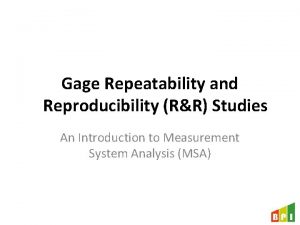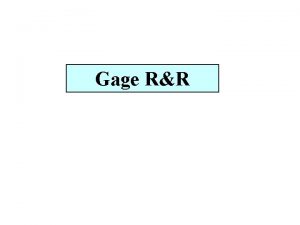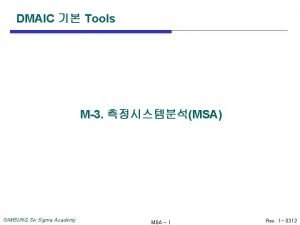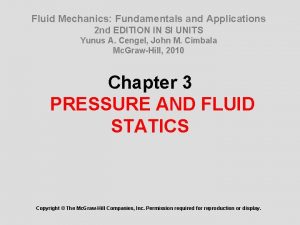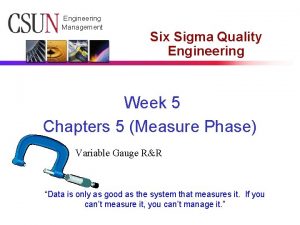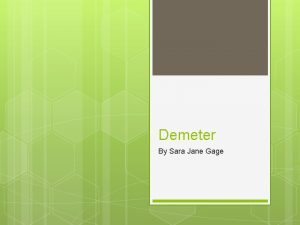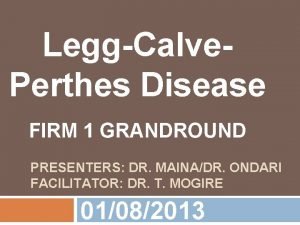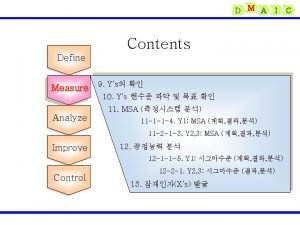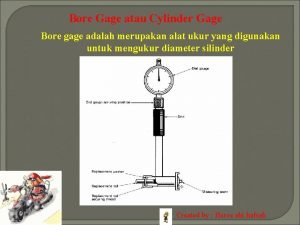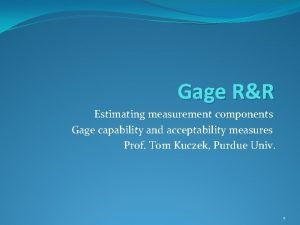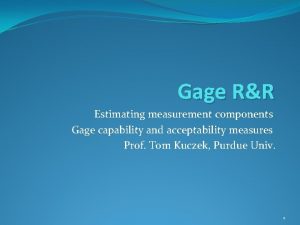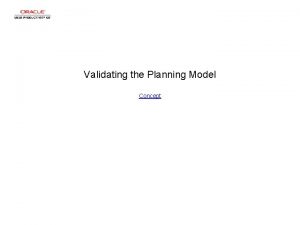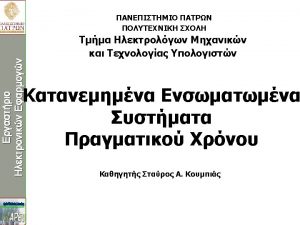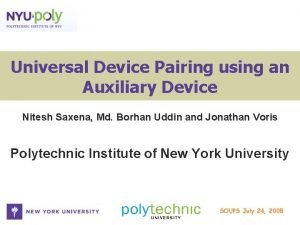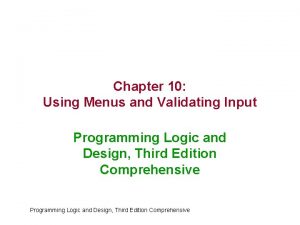Validating a Diagnostic Device Using Gage RR and




























- Slides: 28

Validating a Diagnostic Device Using Gage R&R and DOE Cheryl Pammer Minitab Inc. © 2016 Minitab, Inc.

Agenda Through the use of a customer success story, I will illustrate the successful use of Gage R&R, DOE and Tolerance Interval techniques for demonstrating the capability of a diagnostic test machine. Tools used in the analysis: ► A Gage R&R study for a destructive measurement ► A DOE using a Central Composite Design ► Analysis of both mean and variation of response data © 2016 Minitab, Inc.

Non-disclosure Statement All results and scenarios are based on the authors’ actual experiences. Data units, variable names, etc. have been changed for confidentiality reasons. © 2016 Minitab, Inc.

Gage R&R with Destructive Test • Machine automates the analysis of chemical components in urine used to diagnose various medical conditions. • The goal of this study is to determine whether the variation in glucose measurements obtained from this machine is acceptable. © 2016 Minitab, Inc.

Gage R&R Crossed Overall Variation Part-to-Part Variation Measurement System Variation Repeatability Variation due to operator Reproducibility Operator © 2016 Minitab, Inc. Operator*Part

Standard vs Destructive Gage R&R Standard Study The only way to measure true repeatability is through repeats. Destructive Test These are not repeats! © 2016 Minitab, Inc.

Subsamples for Each Operator Assume these are repeat measurements. Estimate repeatability using crossed analysis. When to Use: Take enough subsamples from the original part to be tested by each operator. Limitation: Repeatability is inflated (Repeatability + Subsample-to-Subsample variation). © 2016 Minitab, Inc.

Estimating Repeatability A single urine sample is split into six subsamples. A glucose reading is taken from each subsample. The six subsamples: ► Are similar enough to represent the same part. ► Provide a measure of repeatability. © 2016 Minitab, Inc.

Sampling Plan for Study ► 20 randomly selected urine samples, each split into 6 subsamples ► 3 randomly selected operators ► Each operator measures 2 subsamples taken from each sample © 2016 Minitab, Inc.

Repeatability Using Subsamples • Subsamples can represent repeat measurements. • Assume within-sample variation is negligible. • Examples: ü Different locations on the same part. ü Subsamples from a single batch, using entire batch. ü Subsamples from a single batch, not using entire batch. © 2016 Minitab, Inc.

Repeatability Component Repeatability = σ2 Within-Gage + σ2 Subsample ► s 2 subsample is assumed negligible. ► High repeatability variation could mean subsamples are non-homogeneous. © 2016 Minitab, Inc.

Results of the Study ► Total Gage R&R variation is 22. 7%. ► The Operator By Sample interaction is the largest source of measurement system variability. © 2016 Minitab, Inc.

Sample by Operator Interaction ► The effect of operator is not the same for each sample. ► Investigate why some samples were harder to measure. © 2016 Minitab, Inc.

Conclusions ► The total Gage R&R is 22. 7%. ► 16. 12% of this variation is due to the interaction between operator and sample. AIAG Guidelines for Total Gage R&R Variation: % Contribution System is… < 1% Acceptable 1% - 9% Marginal > 9% Not Acceptable © 2016 Minitab, Inc.

Design of Experiments Use to efficiently study the effects of several factors on a process. © 2016 Minitab, Inc.

Urinalysis Results The machines automate the analysis of chemical reactions to test strips that measure: • specific gravity • p. H • protein • glucose • ketone • blood • leukocyte • nitrite • urobilinogen • bilirubin • color • clarity Some substances are known to interfere with (bias) measurements of other substances. © 2016 Minitab, Inc.

Design Objectives Objective: Study the potential interference of specific gravity, p. H, and ascorbic acid on mean and variation in glucose readings. Could interference cause the test to miss a high (1900+) glucose reading? Quadratic relationships between the response and the factors are expected. Interactions between factors are also likely. • Factors: Specific Gravity, p. H, Ascorbic Acid • Response: Glucose © 2016 Minitab, Inc.

Response Surface Designs ► Determine effect size ► Investigate interactions ► Fit quadratic models ► Optimize settings Y = b 0 + b 1*A + b 2*B + b 3*A*B + b 4*A 2 + b 5*B 2 + e © 2016 Minitab, Inc.

Central Composite Designs Include: ► Corner points ► Axial points ► Center points © 2016 Minitab, Inc.

Data Collection Plan A single, spiked urine sample with a specific setting of SG, p. H, and AA and glucose of 1900 is split into 6 subsamples. Response: A glucose reading is taken from each subsample. • The sub-samples represent REPEAT measurements, not REPLICATES. • How do we handle repeats and replicates in the analysis? © 2016 Minitab, Inc.

Repeats vs. Replicates Replicate Repeat • Replicate variation is the variation between different samples. Typically used to assess the significance of factors. • Repeat variation is the variation within a single sample. Repeats allow the estimation of the mean and variation when the settings are held fixed. © 2016 Minitab, Inc.

Analysis of Mean and Variation Use Analyze Response Surface Design to analyze the mean and variation of the repeat measurements: ► Response 1: Mean of the repeated glucose readings ► Response 2: Natural log of the standard deviation of the repeated glucose readings © 2016 Minitab, Inc.

Analysis of Variance Results for Mean • The interaction between p. H and AA is significant • The square terms are significant indicating quadratic relationships © 2016 Minitab, Inc.

Effects of SG, p. H, and AA on the Mean The setting at which the interference decreases the glucose reading by the largest amount is: • Specific Gravity = 1. 02 • p. H = 8 • Ascorbic Acid = 100 The mean glucose reading at this worst setting is 1828. 11. © 2016 Minitab, Inc.

Effects of SG, p. H, and AA on Variation Analyze Response Surface Design for the Ln. Std. Dev response produced no significant effects – repeat variation remained constant across settings. © 2016 Minitab, Inc.

Worst-case Interference ► The mean glucose reading is 1828. 11 at the worst setting ► The machine will classify readings into color blocks: ► From past experimentation, the cutoff point at which most samples will fall into the 1900+ color block is 1750. ► Can we be confident that interference would not cause a reading for a sample with true glucose of 1900 to fall below the 1750 cutoff? © 2016 Minitab, Inc.

Conclusions Follow-up experimentation at the worst settings of specific gravity, p. H, and ascorbic acid showed that machine was not likely to miss a high (1900+) glucose reading. © 2016 Minitab, Inc.

Questions? Cheryl Pammer cpammer@minitab. com Dwayne Walker dwalker@minitab. com © 2016 Minitab, Inc.
 Ram input or output device
Ram input or output device Subtitle integration
Subtitle integration A tagout device is preferable to using a lockout device.
A tagout device is preferable to using a lockout device. Precision repeatability and reproducibility
Precision repeatability and reproducibility Phinas gage
Phinas gage Two way anova minitab 17
Two way anova minitab 17 Gageview download
Gageview download Gage r&r training
Gage r&r training U tube manometer formula
U tube manometer formula 미니탭 gage r&r 해석
미니탭 gage r&r 해석 Upd
Upd Terry gage
Terry gage Precision to tolerance ratio
Precision to tolerance ratio Useful block
Useful block Stream gage
Stream gage Gage pressure
Gage pressure Structural properties
Structural properties Gage r&r
Gage r&r Jane demeter
Jane demeter Phineas gage neuropsicologia
Phineas gage neuropsicologia Gazzaniga
Gazzaniga Osteoblat
Osteoblat Gage view
Gage view Gage r&r
Gage r&r Celeste gage
Celeste gage Keystone species definition
Keystone species definition Gxho
Gxho Gage r&r msa
Gage r&r msa Gage definition
Gage definition



